Engine T31 Demolition Tank (USA)
Failures of previous projects did not stop the military and the designers, who were still planning to create and put into service a new engineering machine with a launcher for missiles. The next stage of work in this direction began in November 1944. Earlier this month, a special meeting was held with the participation of representatives of several structures of the US Army, including the Engineering Troops Committee and the Joint Army-Navy Experimental and Testing Board or JANET. As a result of the meeting, the need to develop a new project for an engineering vehicle with special weapons was determined.
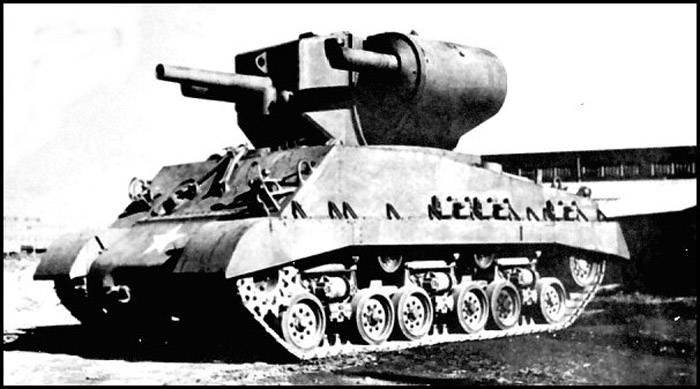
General view of an engineering tank T31. Photo Shushpanzer-ru.livejournal.com
On November 11, the leadership of the Joint Council of JANET sent a request to the Army Support Service to create advanced equipment. The document stipulated the basic requirements for the future engineering tank, from the type of base chassis to the composition of weapons or special equipment. On the basis of existing experience, the specialists of the armed forces formed the original look of a promising armored vehicle, which now was required to be embodied in the form of design documentation and experimental equipment.
Initially, the project of a promising machine class Demolition Tank ("Destructive tank") received the working designation T2. Later, the project was renamed T31 with the preservation of the “name” indicating its role during the battle. Already at the stage of drafting the request, the engineers and JANET specialists agreed on the pace and scope of the work required. As soon as possible, they demanded to build and submit for testing three experimental machines of a new type. Later, the order was adjusted by requesting four prototypes.
It is known that the requirements for the T2 / T31 project were outlined in sufficient detail. The basis of the new machine was to be a modified medium tank chassis M4A3 Sherman. The chassis should have been enhanced protection and the possibility of using some engineering equipment. Especially for a promising tank, it was necessary to develop a new turret with machine-gun armament and immediately two launchers for unguided missiles. Also, an engineering tank was supposed to be equipped with a jet flamethrower.
The requirements for a new engineering tank did not allow us to simply apply the finished equipment, installing some new equipment on it. In accordance with the existing technical requirements, it was necessary to make noticeable changes to the design of the tank chassis, as well as to develop a completely new tower for it. Despite the apparent complexity of this project, all work was completed as soon as possible. The design began in January of 1945, and already in February, the necessary documentation was transferred to the Heinz Manufacturing Company, which was to build four experimental machines.
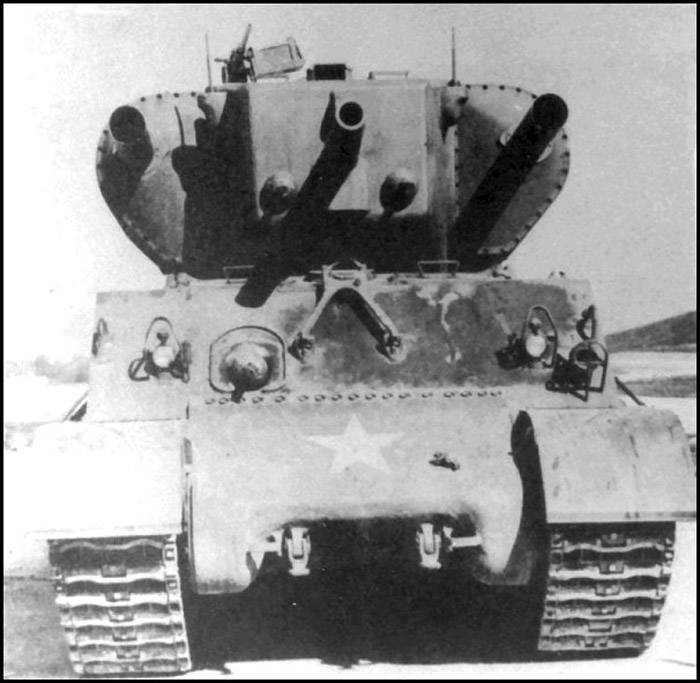
Front view. Photo Shushpanzer-ru.livejournal.com
According to some information, during a certain time, the authors of the project and the contracting company had to work together, the purpose of which was to assemble and study full-scale mock-ups. In the course of such work, it was intended to clarify some features of the project, in particular, to determine the most convenient layout of internal units, etc. Inside the hull and turret, it was required to place a set of various weapons and equipment not previously used on the Sherman family tanks. However, such work did not take much time, so that the optimal layout of the tank was soon found.
As a basis for the engineering tank T31 Demolition Tank, it was required to use the M4A3 Sherman armored vehicle chassis. This modification of the medium tank had a welded armored hull with frontal parts with a thickness of 51 mm and 38-mm sides. The terms of reference stipulated the need to strengthen the protection of the armored vehicle from enemy mines. Because of this, the existing hull of the serial tank received a reinforced bottom with a thickness of 38 mm. In addition, it was proposed to use a wider track for the same purpose. Attachments for a dozer blade or other similar attachments appeared on the case.
The layout of the hull was redesigned according to customer requirements. In front of the case, under the armor cover of a characteristic shape, there were transmission units. Behind them was placed the department of management, in which they also placed part of the elements of flame-throwing weapons. The fighting compartment remained in the center of the corps, part of which was allocated for laying ammunition. The stern contained the engine compartment, under the fighting compartment passed the shaft for connecting the engine and transmission.
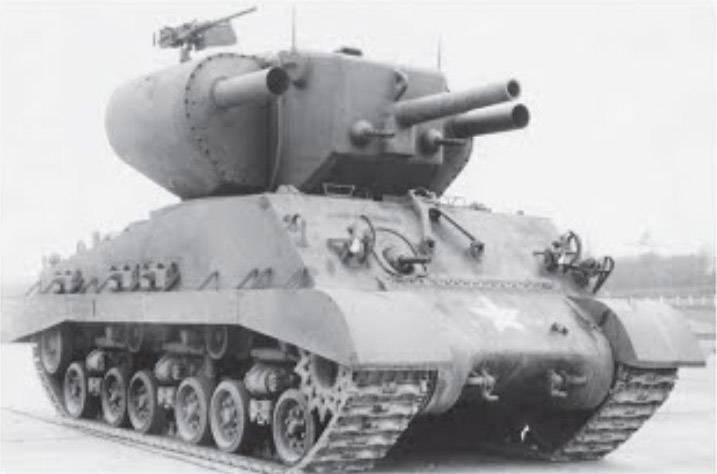
The tank received a recognizable tower. Photo by Zaloga S. "Armored Victory 1945: US Army Tank Combat to Germany's Surrender"
The M4A3 modification tanks were equipped with Ford GAA gasoline engines with 500 horsepower. With the help of a cardan shaft of relatively large length, the engine was connected to a transmission placed in front of the case. The manual transmission had five forward speeds and one reverse.
As part of the chassis on each side there were three carts with two support rollers. Prototypes of the T31 should be built on the basis of the chassis with the type of suspension HVSS. The elastic element of such a suspension was a twisted horizontal spring. Above the intervals between the trolleys on the body were mounted supporting rollers. The drive wheels of the hook gear were located in the front of the hull, in the stern - guides.
The tanks of the base modification had a machine gun in the ball mounting of the front hull sheet. Instead, weapons in the new project was required to use a flamethrower. At the workplace assistant driver in the existing installation is now placed the jet of a flamethrower. In the right front of the hull, they also installed an 50 tank of fire mixture with gallons (about 190 liters) and compressed air tanks needed to emit flammable liquid. Apply a flamethrower was the assistant driver.
As part of the project T2 / T31 a completely new tower was developed, equipped with all the necessary equipment, but compatible with the existing shoulder strap. Requirements for the project did not allow to use the existing unit, because of which the authors of the project had to create a new design that fully complied with the technical task and suitable for the location of the specified weapon. It should be noted that the development of a new tower with unusual weapons led to the formation of an unusual appearance of the “Destructive Tank”, thanks to which this vehicle is very difficult to confuse with other samples of armored vehicles.
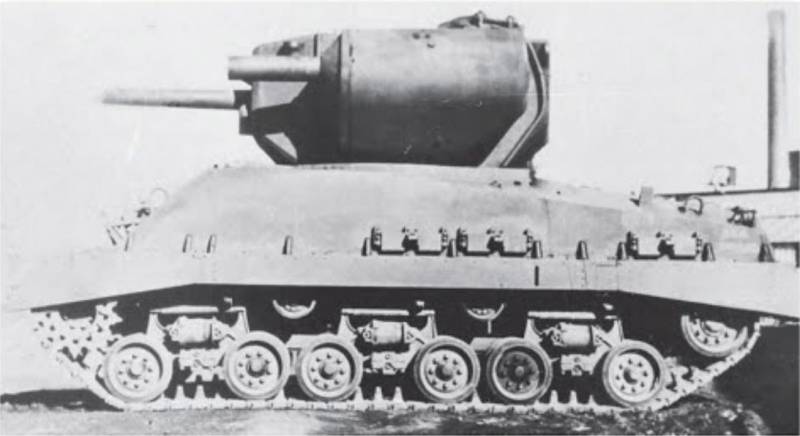
View of the port side. Photo by Zaloga S. "Armored Victory 1945: US Army Tank Combat to Germany's Surrender"
The new type of tower was box-shaped and had to be made of several armor plates and cast parts of various shapes and sizes. The frontal and side projection of the tower was defended by armor 51 mm thick, the stern should have been made 38-millimeter. The tower received a curved frontal sheet with a vertical upper and inclined lower parts. From above it was joined by a narrow roof, on the sides - trapezoidal zygomatic sheets. The central part of the tower had a rectangular shape, and the stern was made in the form of a curved cast part with an opening for installing doors. On the roof of the tower was a commander's cupola, which was a modified version of the existing product of serial tanks. To improve the view from the car, which was distinguished by its great height, the turret was additionally raised to 76 mm.
At the bottom of the frontal plate were placed two ball mounts for machine guns M1919 caliber 7,62 mm. They could be induced independently within certain sectors and were intended to protect against manpower or unarmored enemy vehicles. In the center of the frontal sheet the pipe was rigidly fastened, which was an imitator of 105-mm howitzers. The dense layout of the combat compartment did not allow the tank to be equipped with a real weapon, but the authors of the project considered that the armored vehicle needed means to imitate such weapons. The last element of the barrel armament complex was the high-caliber machine gun M2HB mounted next to the commander's turret.
On the sides of the tower project T31 proposed to mount the original launchers such as T94. From bullets and fragments, the installation was protected by an armor cover consisting of two parts. There was a front curved sheet with a round hole for outputting a guide tube. On the side and in the back, the internal devices of the installation were covered with a cast casing of complex shape with a sloping lower part of the stern. In addition, in the stern of the casing there was a hole for the withdrawal of powder gases.
According to reports, the T94 launcher had a fairly simple design. A drum of a revolving type with five cells was placed inside the casing to accommodate unguided rockets. When using weapons, the drum, using its own drive, had to rotate around the longitudinal axis, alternately leading to a protruding tubular guide cell with rockets. At the start of the command, the electrical system ignited the solid-fuel rocket engine. Powder gases were discharged through a window in the stern of the launcher.
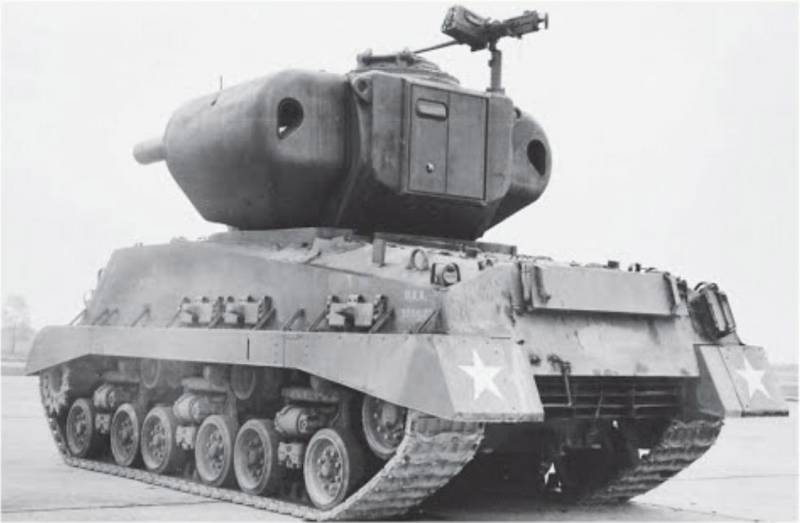
View of the stern. Photo by Zaloga S. "Armored Victory 1945: US Army Tank Combat to Germany's Surrender"
It was proposed to reload the drum from the fighting compartment. For this, the crew had to open the hatch in the side hull and install new rockets into the drum. After that, you could continue shooting. Two launchers could carry ready-to-use ammunition in the form of 10 missiles. Another two dozen shots were placed in the styling of the crew compartment and could be used after reloading the drums.
T94 launchers were supposed to use 7,2 inch (183 mm) unguided solid-fuel rocket missiles. There is reason to believe that the T31 type rocket or some product based on it was considered as the main ammunition for the T37 tank. This missile was an upgraded version of the ASW Mk20 / 22 anti-submarine ammunition complex and could be used on land. The rocket had a large body with a warhead and a fuse, as well as a tubular shank with an engine and a ring stabilizer. The length of the product was 890 mm, starting weight - 28 kg, of which 15 kg accounted for the charge of the warhead.
Part of the documentation for the T31 Demolition Tank project was transferred to the Heinz Manufacturing Company, which was appointed as an expert equipment assembler, as early as February 1945. However, it was not possible to quickly complete all the required work. For various reasons, the assembly of the first experienced engineering tank began only in April of the same year. The first prototype was supposed to be used to confirm the design characteristics, which is why the tower was decided to be made of structural steel. The assembly of the prototype was completed in August.
Directly from the factory, the first T31 tank was sent to the Aberdeen Proving Ground, where a demonstration of promising technology was held to representatives of the military department. The unusual machine was shown to the command of armored and engineering troops. After that, the tank came to the test, during which he had to show the characteristics of mobility and demonstrate the fighting qualities. The presence of three machine guns, a flamethrower and two launchers for unguided missiles made it possible to count on obtaining high characteristics.
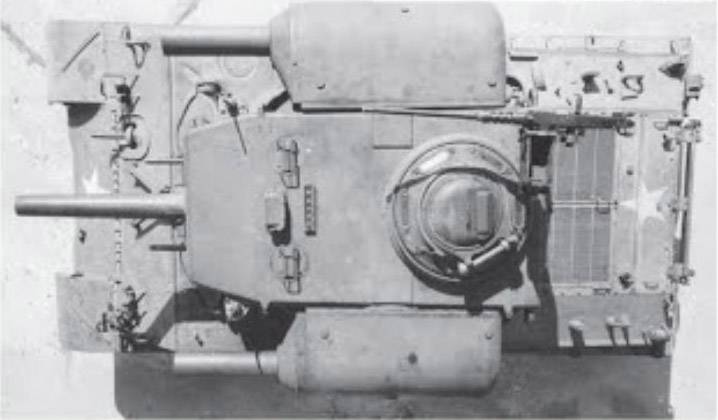
View from above. Photo by Zaloga S. "Armored Victory 1945: US Army Tank Combat to Germany's Surrender"
According to reports, there were no problems with barreled weapons. For self-defense, an engineering tank had to use relatively old and well-mastered machine guns, which had long been free from shortcomings. Problems began when checking the T94 launchers, the main weapon of the armored vehicle. As planned by the authors of the project, the crew of the tank was supposed to load rockets into two drums, after which it could consistently make ten shots (single or in two volleys). This was followed by recharging. The dimensions of the ammunition stack allowed to empty both drums three times.
In practice, everything turned out to be much more complicated. From the very beginning of the test there were problems with the drives of the rotation of the drum launchers. The existing mechanisms did not cope with the load, which required the intervention of the crew at different stages of preparation for the shooting. Finally, during the next test, the left launcher drum jammed, after which one of the T94 products lost the ability to solve the assigned tasks. The right installation at the time of completion of the tests also remained without a regular drive. Her drum still could be turned, but now it had to be done manually. Similar failures of the main weapon did not allow to continue the tests. Repairs and fine-tuning of T94 installations - if they were carried out - were not completed.
Tests of a promising engineering tank began literally a couple of weeks before the end of the Second World War. The end of hostilities led to a natural reduction in funding, which caused the US military to close some of the developed projects of new combat vehicles, as well as cut costs for others. The first consequence of these events in the context of the T31 project was the abandonment of the construction of three additional prototypes required by the original order. Tests have shown that the construction of such equipment does not make sense: the first prototype did a good job with the task of demonstrating the existing shortcomings and problems.
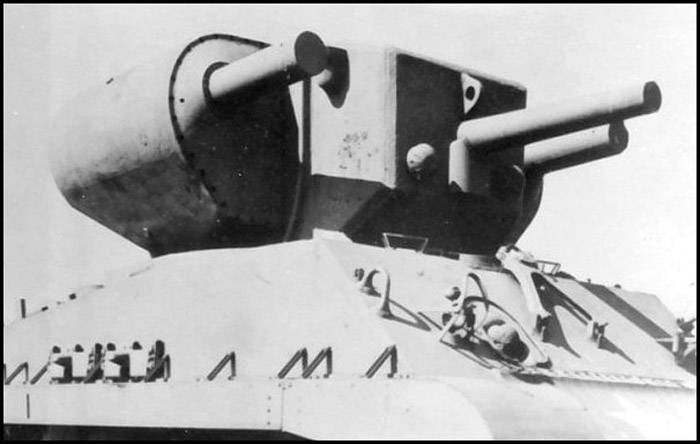
Tower with two machine guns and launchers T94. Photo Shushpanzer-ru.livejournal.com
Breakdowns of launchers led to the actual end of the tests. For some time, the customer and the performers decided the fate of the project. Experts rightly felt that the proposed design of an armored engineering vehicle has a number of problems, the correction of which takes time. In addition, the engineering tank was based on the M4A1 Sherman armored vehicle chassis, which had already been removed from mass production. In its current form, the T31 project had no real prospects and was not of interest to the army. 14 January 1946 of the year. An order was issued for the complete cessation of work on the T31 Demolition Tank project.
By the time the project was officially closed, the contractor enterprise had built only one prototype of a promising engineering tank with rocket, machine-gun and flame-throwing weapons. Other cars were not collected and, from a certain time, they were not even planned. After completion of the tests, the only prototype T31 went to storage, and then was disassembled as useless.
During World War II, the United States industry made several attempts to create engineering tanks capable of destroying obstacles and strengthening the enemy using unguided rockets with a relatively heavy explosive charge. Several versions of such a vehicle, built on the basis of the M4 Sherman medium tank, came to the test, but could not show acceptable performance and interest the potential operator. A number of interesting projects remained in stories as a curious technical curiosity. The unusual engineering tank T31 Demolition Tank also could not avoid such a sad fate.
Based on:
http://armor.kiev.ua/
http://shushpanzer-ru.livejournal.com/
Hunnicutt RT Sherman. A History of the American Medium Tank, Navato, CA. Presidio Press, 1971
Zenith X. Armored Victory 1945: Stackpole Books, 2012
Information